coolant level BUICK CENTURY 1996 Owners Manual
[x] Cancel search | Manufacturer: BUICK, Model Year: 1996, Model line: CENTURY, Model: BUICK CENTURY 1996Pages: 340, PDF Size: 17.61 MB
Page 182 of 340
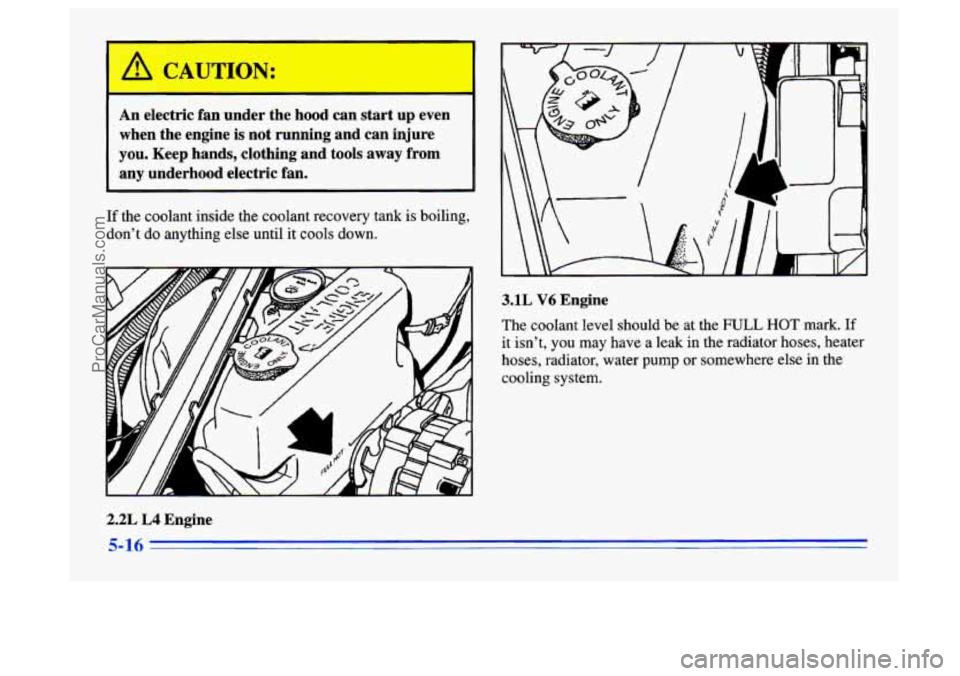
(ACA u TT” I:
An electric fan under the hood can start up even
when the engine is not running and can injure
you. Keep hands, clothing and tools away from
any underhood electric fan.
If the coolant inside the coolant recovery tank is boiling,
don’t
do anything else until it cools down.
2.2L L4 Engine
3.1L V6 Engine
The coolant level should be at the FULL HOT mark. If
it isn’t, you may have a leak in the radiator hoses, heater
hoses, radiator, water pump or somewhere else in the
cooling system.
5-16
ProCarManuals.com
Page 183 of 340
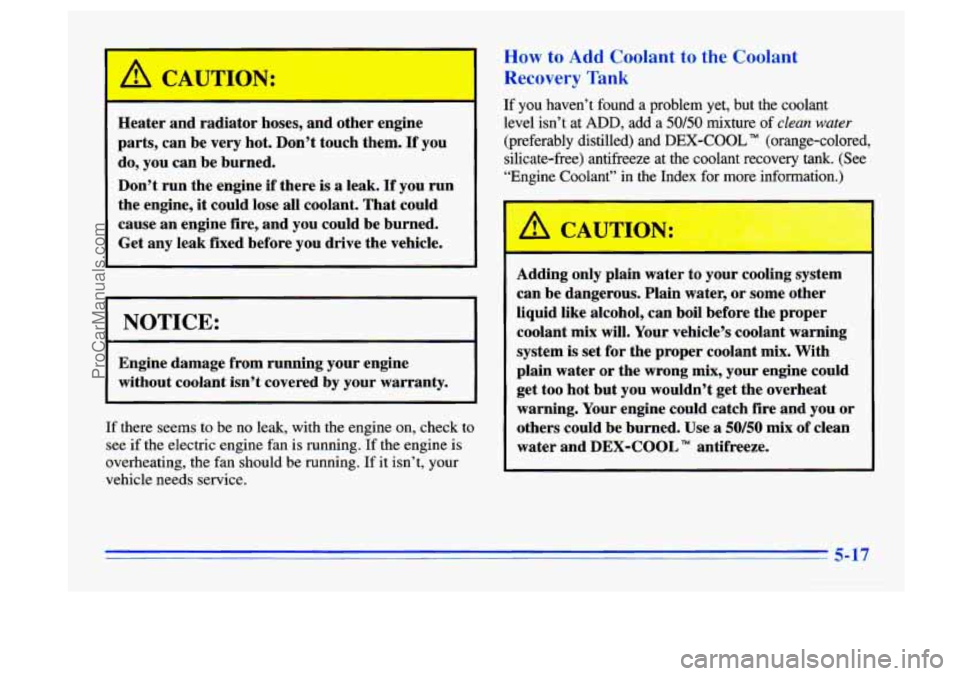
A C U-ION:
Heater and radiator hoses, and other engine
parts, can be very hot. Don’t touch them.
If you
do, you can be burned.
Don’t run the engine if there
is a leak. If you run
the engine,
it could lose all coolant. That could
cause an engine fire, and you could be burned.
Get any leak fixed before you drive the vehicle.
NOTICE:
Engine damage from running your engine
without coolant isn’t covered by your warranty.
If there seems to be no leak, with the engine on, check to
see if the electric engine fan is running. If the engine is
overheating, the fan should
be running. If it isn’t, your
vehicle needs service.
How to Add Coolant to the Coolant
Recovery Tank
If you haven’t found a problem yet, but the coolant
level isn’t at ADD, add a
50/50 mixture of clean water
(preferably distilled) and DEX-COOL (orange-colored,
silicate-free) antifreeze at
the coolant recovery tank. (See
“Engine Coolant” in the Index for more information.)
Adding only plain water to your cooling system
can be dangerous. Plain
water, or some other
liquid like alcohol, can boil before the proper
coolant mix will. Your vehicle’s coolant warning
system
is set for the proper coolant mix. With
plain
water or the wrong mix, your engine could
get too hot but you wouldn’t get the overheat
warning. Your engine could catch fire and you or
others could be burned. Use
a 50/50 mix of clean
water and DEX-COOL
TM antifreeze.
5-17
ProCarManuals.com
Page 189 of 340
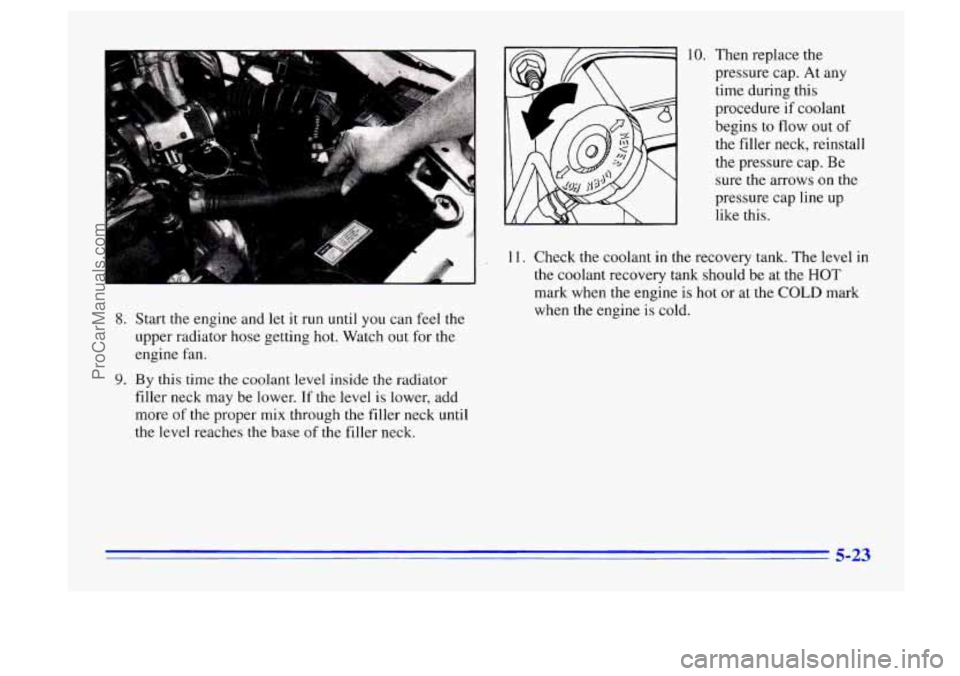
8. Start the engine and let it run until you can feel the
upper radiator hose getting hot. Watch out for the
engine fan.
9. By this time the coolant level inside the radiator
filler neck may be lower.
If the level is lower, add
more
of the proper mix through the filler neck until
the level reaches the base of the filler neck. 10.
Then replace the
pressure cap. At any
time during this
procedure
if coolant
begins to
flow out of
the filler neck, reinstall
the pressure cap. Be
sure the arrows on
the
pressure cap line up
like this.
11. Check the coolant
in the recovery tank. The level in
the coolant recovery tank should be at the HOT
mark when the engine is hot or at the COLD mark
when
the engine is cold.
5-23
ProCarManuals.com
Page 216 of 340
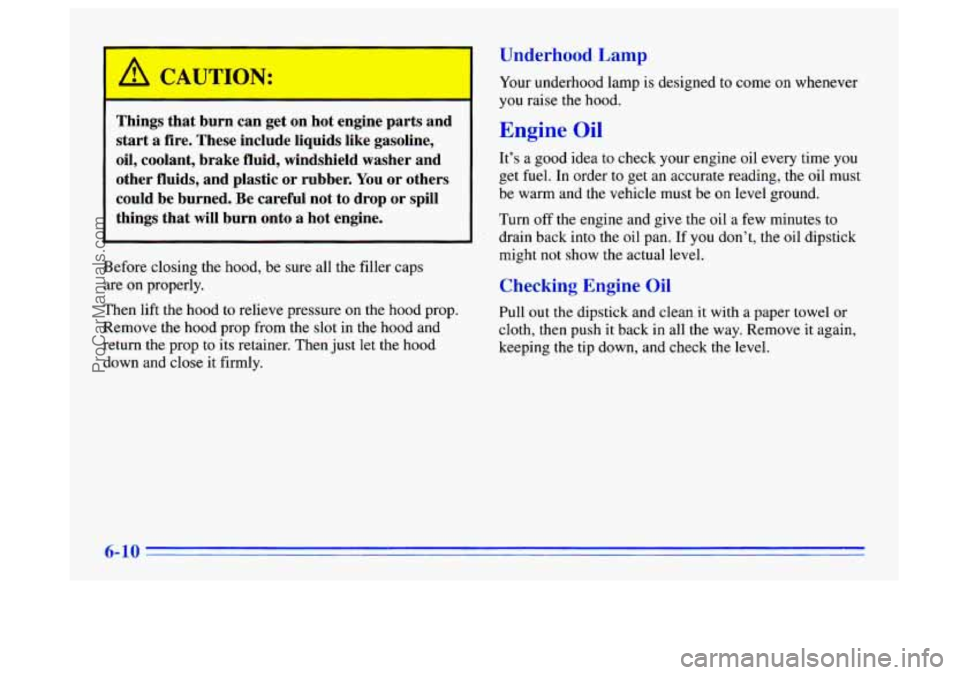
Things that burn can get on hot engine parts and
start a fire. These include liquids like gasoline,
oil, coolant, brake fluid, windshield washer and
other fluids, and plastic or rubber. You or others
could be burned. Be careful not
to drop or spill
Underhood Lamp
Your underhood lamp is designed to come on whenever
you raise the hood.
Engine Oil
It's a good idea to check your engine oil every time you
get fuel. In order
to get an accurate reading, the oil must
be warm and the vehicle must be on level ground.
things that will burn onto a hot engine. Turn off the engine and give the oil a few minutes to
drain back into the oil pan. If you don't, the oil dipstick
Before closing the hood, be sure all the filler caps
are on properly.
Then lift the hood
to relieve pressure on the hood prop.
Remove the hood prop from the slot in the hood and
return the prop
to its retainer. Then just let the hood
down and close
it firmly. might
not show the actual level.
Checking Engine Oil
Pull out the dipstick and clean it with a paper towel or
cloth, then push it back in all the way. Remove it again,
keeping the tip down, and check the level.
6-10
ProCarManuals.com
Page 230 of 340
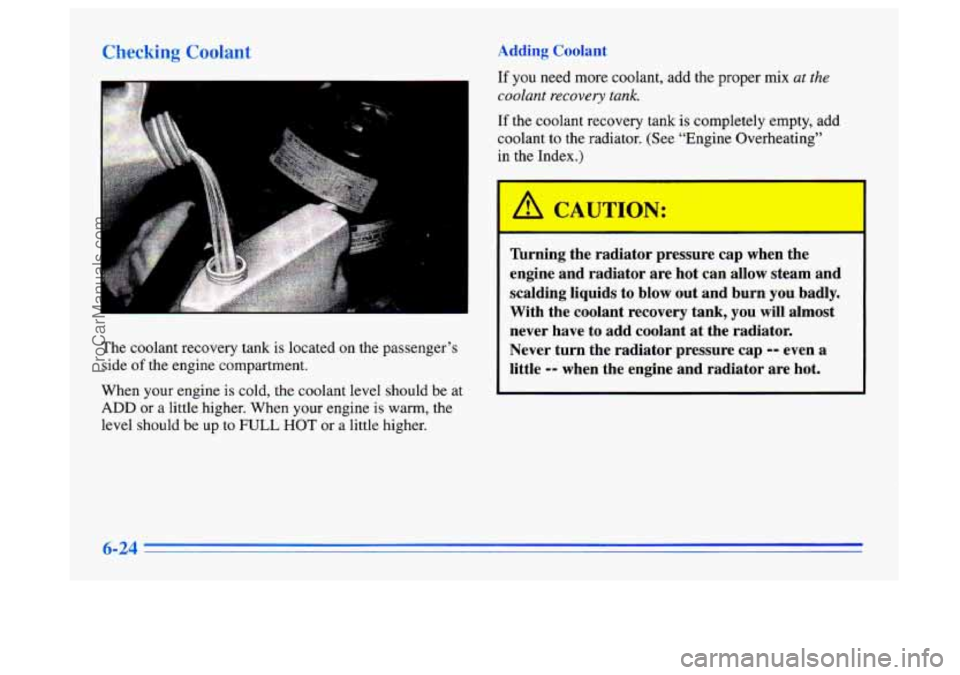
rhacking Coc’mt * clding Coolant
!
The coolant recovery tank is located on the passenger’s
side
of the engine compartment.
When your engine is cold, the coolant level should be at
ADD or a little higher. When your engine is warm, the
level should be up to
FULL HOT or a little higher.
.
If you need more coolant, add the proper mix at the
coolant recovery tank.
If the coolant recovery tank is completely empty, add
coolant to the radiator. (See “Engine Overheating”
in the Index.)
I-
Thrning the radiator pressure cap when the
engine and radiator are hot can allow steam and
scalding liquids to blow out and burn you badly.
With the coolant recovery tank, you
will almost
never have to add coolant at the radiator.
Never turn the radiator pressure
cap -- even a
little
-- when the engine and radiator are hot.
ProCarManuals.com
Page 306 of 340
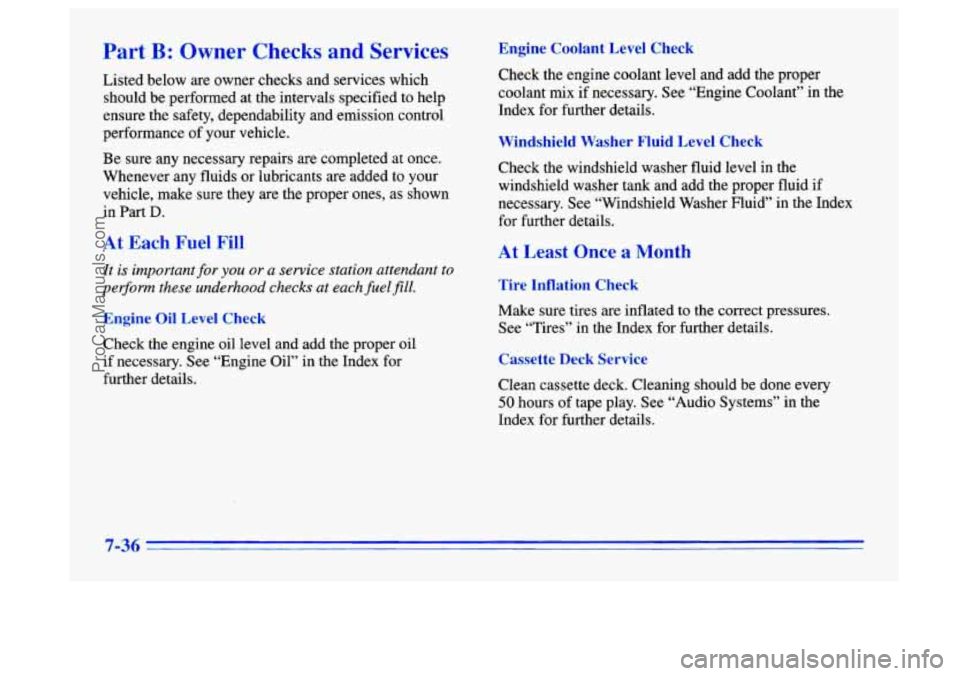
Part B: Owner Checks and Services
Listed below are owner checks and services which
should be performed at the intervals specified to help
ensure the safety, dependability and emission control
performance of your vehicle.
Be sure any necessary repairs are completed at once.
Whenever any fluids or lubricants are added to your
vehicle, make sure they are the proper ones, as shown
in Part
D.
Engine Cc --ant - - el Chc -’L
Check the engine coolant level and add the proper
coolant mix if necessary. See “Engine Coolant” in
the
Index for further details.
Windshield Washer Fluid Level Check
Check the windshield washer fluid level in the
windshield washer tank and add the proper fluid if
necessary. See “Windshield Washer Fluid” in the Index
for further details.
At Each Fuel Fill
It is important for you or a service station attendant to
perform these underhood checks at each fuel fill.
At Least Once a Month
Tire Inflation Check
Engine Oil Level Check Make sure tires are inflated to the correct pressures.
See “Tires”
in the Index for further details.
Check the engine oil level and add the proper oil
if necessary. See “Engine Oil” in the Index for
further details.
Cassette Deck Service
Clean cassette deck. Cleaning should be done every
50 hours of tape play. See “Audio Systems” in the
Index for further details.
7-36
ProCarManuals.com
Page 331 of 340
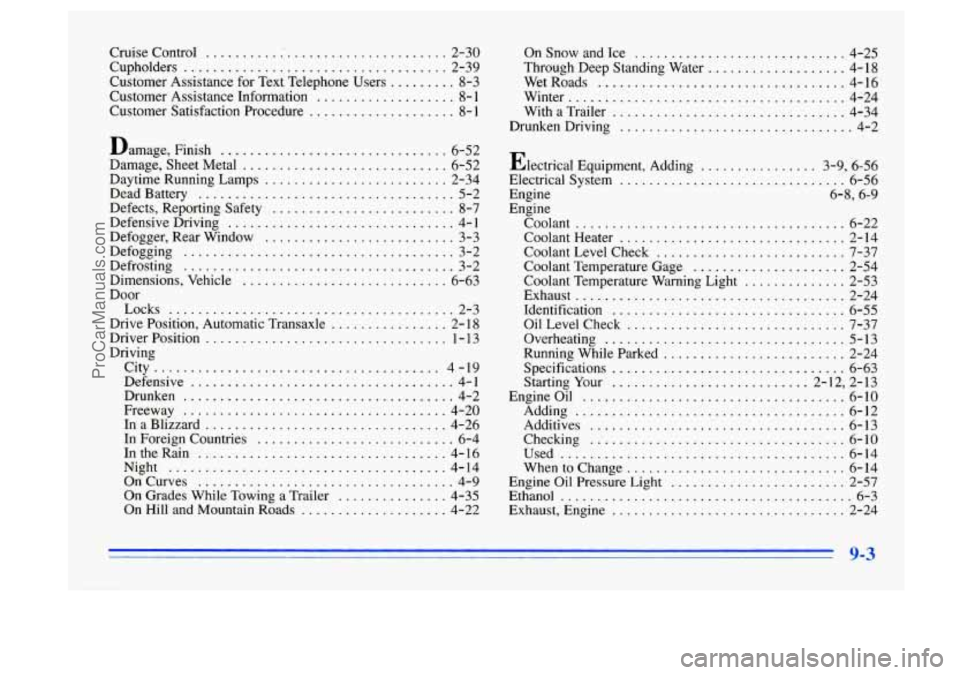
Cruise Control .................................. 2-30
Cupholders
.................................... 2-39
Customer Assistance Information
................... 8- 1
Customer Satisfaction Procedure .................... 8- 1
Damage. Finish ............................... 6-52
Damage. Sheet Metal
............................ 6-52
Daytime Running Lamps
......................... 2-34
Dead Battery
................................... 5-2
Defects. Reporting Safety
......................... 8-7
Defensive Driving
............................... 4- 1
Defogger. Rear Window
.......................... 3-3
Defogging
..................................... 3-2
Defrosting
..................................... 3-2
Dimensions. Vehicle
............................ 6-63
Door
Drive Position. Automatic Transaxle
................ 2- 18
Driver Position
................................. 1 - 13
Driving
City
....................................... 4-19
Defensive
.................................... 4-1
Drunken
..................................... 4-2
Freeway
.................................... 4-20
In a Blizzard ................................. 4-26
In Foreign Countries
........................... 6-4
IntheRain
.................................. 4-16
Night
...................................... 4-14
OnCurves
................................... 4-9
On Grades While Towing a Trailer ............... 4-35
On Hill and Mountain Roads
.................... 4-22
Customer Assistance for
Text Telephone Users
......... 8-3
Locks
....................................... 2-3 OnSnowandIce
............................. 4-25
Wet Roads
.................................. 4-16
Winter ...................................... 4-24
With a Trailer
................................ 4-34
DrunkenDriving
................................ 4-2
Electrical Equipment. Adding
................ 3-9. 6-56
Electrical System
............................... 6-56
Engine 6-8. 6-9
Engine
Coolant
..................................... 6-22
Coolant Heater
............................... 2-14
Coolant Level Check
.......................... 7-37
Coolant Temperature Gage
..................... 2-54
Exhaust
..................................... 2-24
Identification
................................ 6-55
OilLevelCheck
.............................. 7-37
Overheating
................................. 5-13
Running While Parked ......................... 2-24
Specifications
................................ 6-63
Starting Your
........................... 2- 12. 2-13
Engineoil
.................................... 6-10
Adding
..................................... 6-12
Additives
................................... 6-13
Checking
................................... 6-10
Used
....................................... 6-14
Whentochange
.............................. 6-14
Engine
Oil Pressure Light ........................ 2-57
Ethanol
........................................ 6-3
Through Deep Standing
Water
................... 4-18
Coolant Temperature Warning Light
.............. 2-53
Exhaust. Engine
................................ 2-24
9-3
ProCarManuals.com